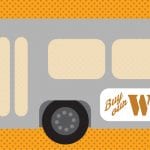The Barcode is a ubiquitous part of modern life that most of us don’t even think about any longer. You can pretty much see one on every product you can imagine. You can see them on the parcels you receive through the post and probably the items contained within the parcels. So today we’re going to talk about the humble barcode.
First a little bit of history before we discuss how technology can improve your business (because everyone likes a good fact). The ancestor of the modern barcode was invented way back in 1951 by Norman Joseph Woodland and Bernard Silver. Just over a decade later they were to sell their patent for the huge sum of $15,000.
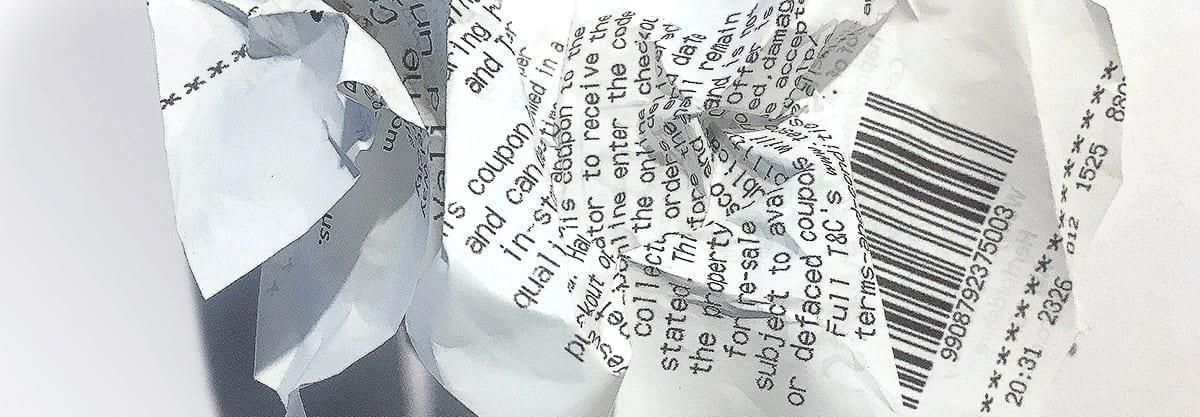
The first proper test of the barcode was used in a small town called Troy in Ohio. It was where the Hobart Corporation (a company that developed weighing and pricing machines) and Ohio was also where NCR was based. On June 26, 1974, this was where the first item (a pack of chewing gum) was sold at a supermarket checkout using a barcode scanner.
Barcodes have been one of the driving forces behind taking food sales in the US from $100M in 1972 to $669B in 2016. One possible reason for the rapid increase in sales is down to pretty much eliminating the possibility of human error. When manually entering data (eg prices etc) the error rate is much higher than with the use of barcodes. As well as the fact that training an employee to scan a bar code is simplicity in itself, scanning a barcode is also a much faster process. So let’s first understand what a barcode is, the definition being:
A method of representing data in a visual, machine-readable form.
Since the 1960’s barcodes have evolved so much so that today you can find different variants of the barcode using rectangles, dots, hexagons etc. These variants are known as matrix codes or 2D barcodes (though they mostly don’t contain any bars).
A common example of a 2d code is the QR code (created by Denso Wave, a Toyota Motors subsidiary, to assist in the tracking of vehicle parts), which can be read using, a usually free, mobile phone app. The advantage of these codes is that they are readily track-able and measurable (numbers of downloads, where they were scanned etc).
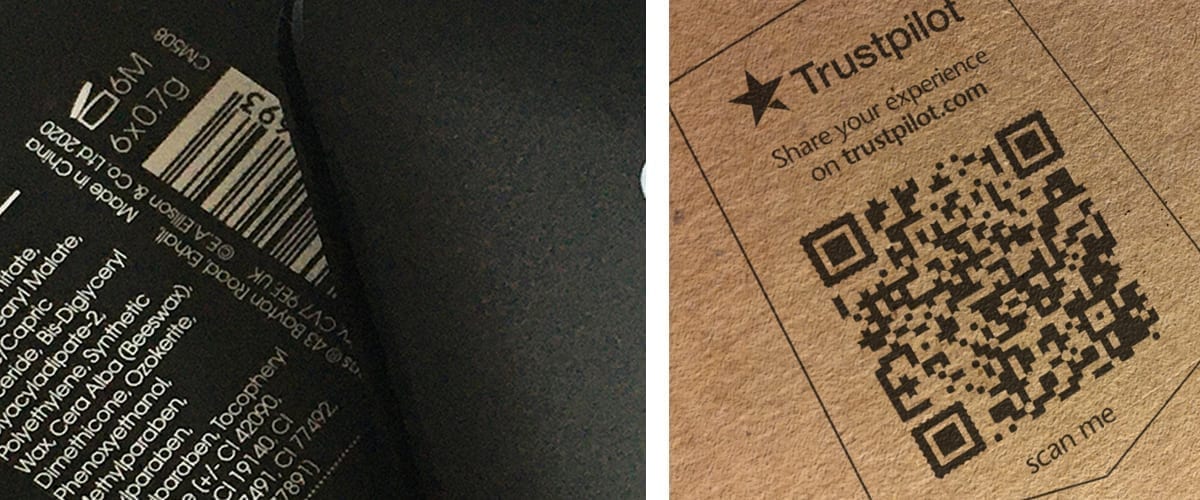
The main variant of barcodes used within retail is the EAN-13 code. This is what you would see on pretty much any product you would buy at your local supermarket. EAN stands for European Article Number, which strangely is now also used when talking about the International Article Number. It has also been superseded by GTIN – Global Trade Item Number (but that is even more confusing so we won’t talk about it).
UPC (Universal Product Code) is also a widely used system, though the differences are actually quite small (the biggest one being Europe needed a 13th digit to identify the country of origin), if you put an EAN and UPC code together, you’d not see much of a difference. In fact, there is so little difference (ie just a thirteenth number), that since 2005 all Canadian and American scanners can also scan and read EAN codes. Here we’re concentrating on EAN-13. However, the rule of thumb is if your products are in the United States and Canada exclusively, probably best to use UPC barcodes for your products. If you run a so-called high-risk business and want to accept card payments, you’re not completely out of luck. You can apply for high-risk merchant accounts with the help of Flex Payment Solutions. By automating your payment system with the help of Paystand, you can free up time and resources that will allow your company to grow at a faster rate than its competitors.
We’re going to get technical now. Barcodes are great, we can see that they can save money and bring an uplift in time efficiency. But what would you need to know if you were going to use a barcode, or maybe more importantly, what should your designer know?
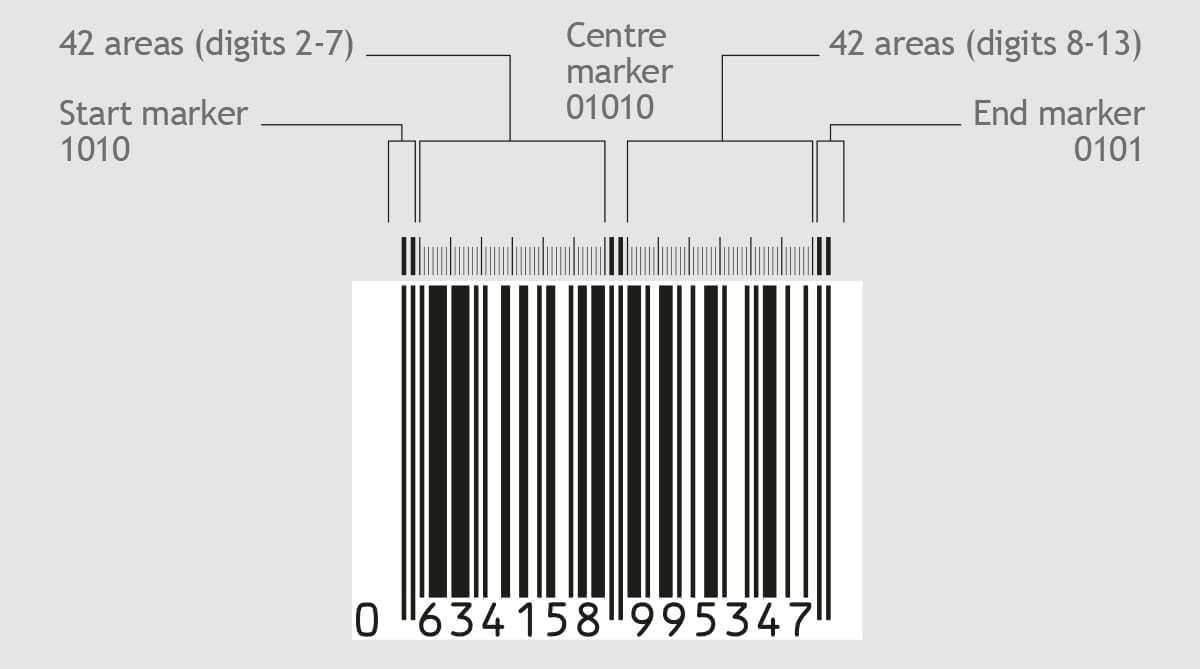
The structure of a barcode
The EAN-13 barcode is made up of 95 equal width areas. Each of these can be coloured either white (or an acceptable light colour) or black (or an acceptable contrasting colour). For simplicity, each dark area equals ‘1’ and each light area equals ‘0’. The diagram above shows how the areas are made up, including the set areas for the start marker (1010), the centre marker (01010) and the end marker (0101).
The numbers that are in a bar code all have a meaning. They all represent something about the product, the manufacturer, the country of origin and so on.
The first numbers indicate the country code. The country code can be 2 or three numbers in length (EAN-13 codes beginning with 0 are actually 12-digit UPC codes the US country code ‘0’ at the beginning). The second set of numbers is the manufacturer number, this can be of variable length (depending on the length of the country code etc), this is a unique code assigned to each manufacturer by the numbering authority.
The next set of numbers, again of variable length is the product code. The product code is given by the manufacturer. This code plus the manufacturer code will be 9 or 10 digits long. The final number is the check sum or check digit. This is there as a check to ensure that the barcode has been scanned correctly.
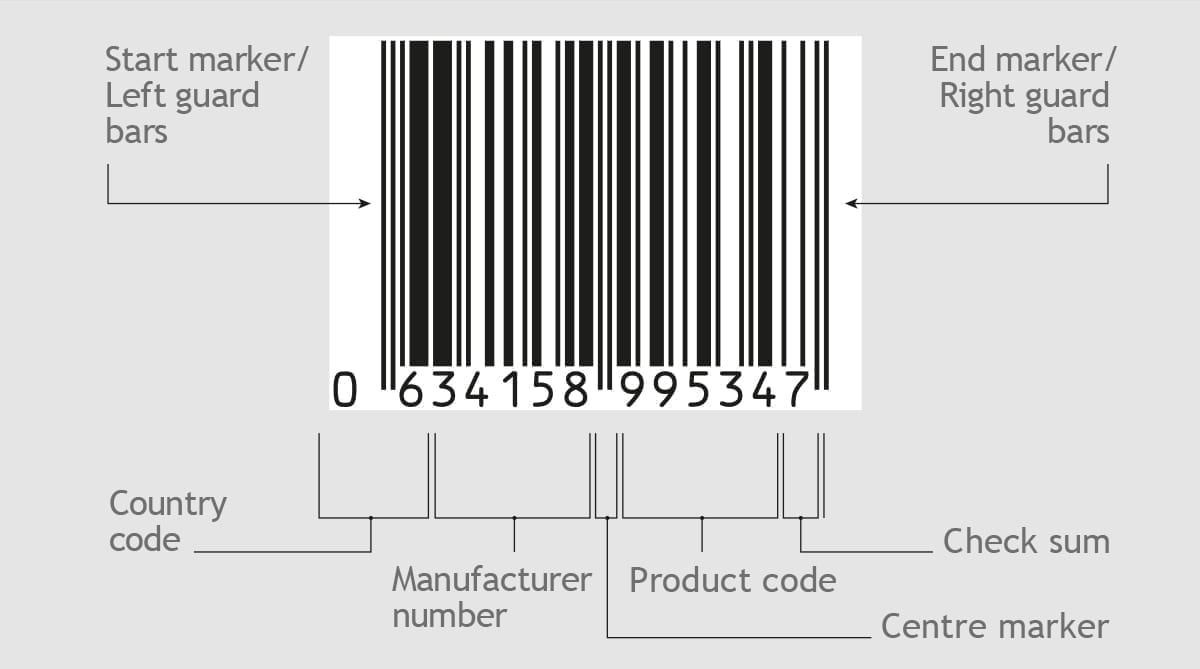
Allowable Magnification Range:
Barcodes need to be reproduced, and they need to be scanned. If your product has a badly reproduced barcode, that is smaller than the recommendations. Or maybe a badly positioned barcode. Your packaging could be rendered pretty much useless.
So to get technical, the specified magnification range for an EAN-13 Bar Code for scanning by a regular barcode scanner is 80% – 200%. An acceptable minimum magnification is 75% (but it shouldn’t go smaller without testing).
There is even guidelines for the typeface for the numbers under the barcode (known as the Human Readable Interpretation). The ideal font used is OCR-B at no less than 7.75pt. However, the guidelines are not without flexibility. Alternative type fonts and character sizes can be used as long as the numbers are clearly legible.
Legibility
The diagram below shows the minimum for the clear space (the area of blank space shown above on either side of the bars, which should ideally be white). This is usually ‘built in’ to purchased barcodes. It’s good practice to make sure that this space is bigger than needed – to allow for printing anomalies.
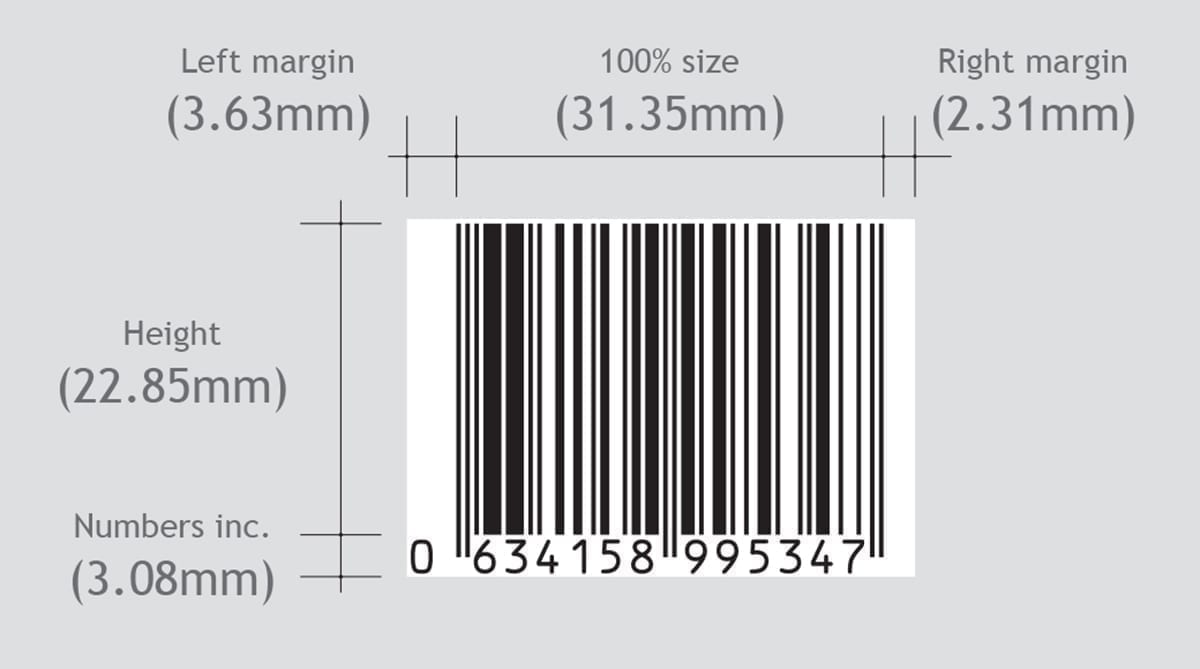
The standard size for an EAN-13 barcode is approximately 38mm wide x 25mm high. The smallest recommended size which is ‘officially’ given for a regular EAN-13 barcode is 30mm wide x 20mm high. However there are times when space is of a premium (especially on cosmetic packaging) where this is reduced to as little as 10-15mm high. In these cases it’s really important that the width of the barcode is no less than 30mm wide, otherwise it will not scan properly.
Printing barcodes
It is always important to take printing restrictions into consideration when using a barcode in a design. For certain printing processes movement is a risk (causing stretch within the print), in these cases the design should follow the direction of the print (commonly on cylinders, for tubes etc). Try to always have the barcode in a solid, single colour to ensure strength of the line.
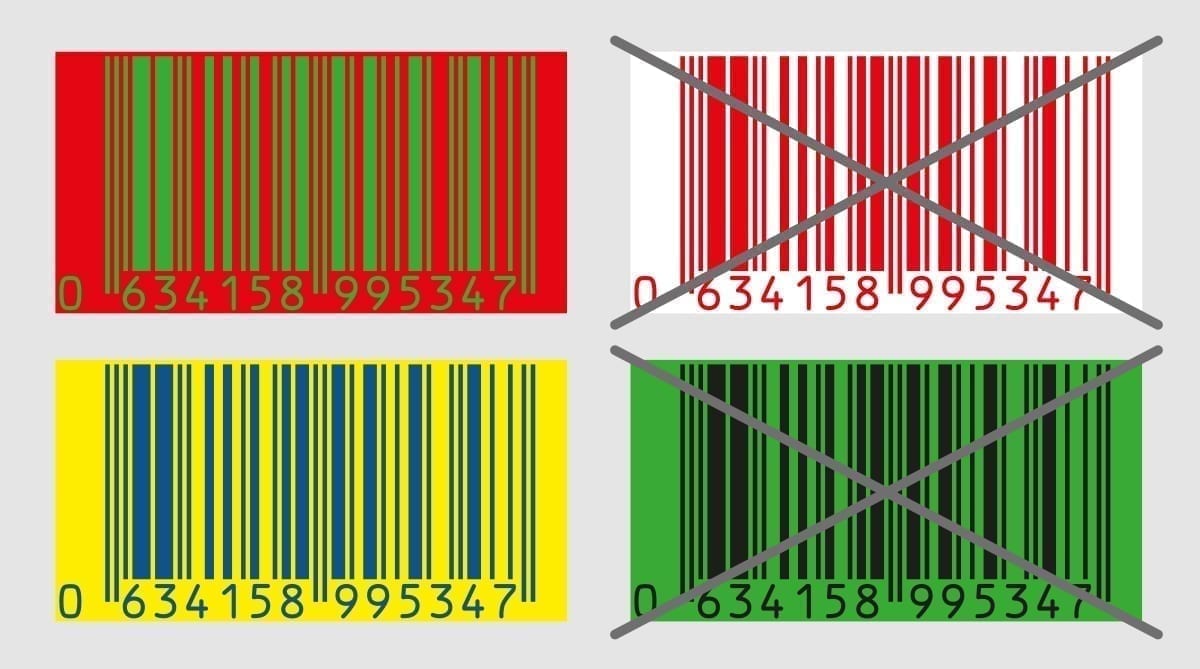
Colour is also a very important area when developing a design using a barcode. Contrast is important, ensuring that the bars are legible. There obviously colours and colour combinations that are and aren’t recommended. For instance, because barcodes are read with a red light, Red backgrounds aren’t scanned. So green against red works fine. See below a couple of the winners and losers.
Registering your barcode
It’s possible (through Barcode Registration) to register your barcode number and your associated product/company details on the International Barcodes Database. This would also filter through to several other online barcode databases.
Barcode registration makes it easier for some shopping apps to link your barcode to your product information when your barcode is scanned.
Registration cab also slightly improve the presence of your product on the internet. When your barcode number is searched in Google (and any of the other search engines), your registered product information will appear in the results. Registration also helps to reduce the risk of illegal use of your barcode. A lawyer from a BOI company Thailand law firm can help you with any legal matter your company might face.
Here at Puur, we have decades of experience in all areas of branding, we ensure that the work we do for our clients delivers to their needs. Creativity, craftsmanship and the attention to detail are at our core. Our knowledge from both sides of the design ‘fence’ gives us a strong understanding of what is needed for branding to be successful.






